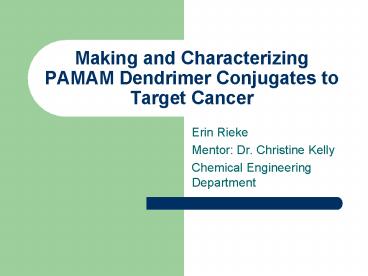Making and Characterizing PAMAM Dendrimer Conjugates to Target Cancer PowerPoint PPT Presentation
1 / 16
Title: Making and Characterizing PAMAM Dendrimer Conjugates to Target Cancer
1
Making and Characterizing PAMAM Dendrimer
Conjugates to Target Cancer
- Erin Rieke
- Mentor Dr. Christine Kelly
- Chemical Engineering Department
2
Cancer What is it and why is it hard to treat?
- Uncontrolled division of cells that forms tumors
- Can get into blood system and spread
- Cells are not foreign like with infection, etc.
- Current treatments radiotherapy, chemotherapy,
immunotherapy expose normal tissue too - Need to target cancer cells
- Hard because fundamentally cells are like all
others
3
Our Strategy Nanoparticle Based Immunotherapy
- Immunotherapy uses bodys own immune system to
combat cancer - IL-12 used to activate natural killer cell
activity - IL-12 is toxic when given systemically
- Possible treatment - nanoparticles functionalized
with IL-12 and targeting agent
4
Our Strategy Targeting Angiogenesis
- Tumor growth needs nutrients
- Tumors cause body to grow new blood vessels
angiogenesis - New blood vessels branch from old ones
- Vessels lined with endothelial cells
- These endothelial cells express special markers
5
Our Strategy Targeting Angiogenesis
- Endothelial cells of new blood vessels express
integrin aVß3 - Tripeptide sequence, arginine-glycine-aspartic
acid (RGD), binds to integrin - Many small peptides available with RGD sequence
- RGD-4C, RGD sequence stablized with two disulfide
bridges, shown to strongest affinity for integrin
aVß3
6
PAMAM Dendrimer Tying it all Together
- Polyamidoamine (PAMAM) dendrimer nanoparticle
- Ethylenediamine-core
- Tertiary amine nitrogens carry two branched
amidoamine groups - Dense star created by repeated series of
reactions - Each reaction adds 2 binding sites to each
tertiary amine - Use generation 5 dendrimer - 5.4 nm with 128
terminal functional amine groups
7
My Work Making the Functionalized Dendrimer
- Add FITC molecules
- Add RGD-4C targeting peptide
- Analyzing product to know
- How many FITC?
- RGD-4C successfully added?
- How many RGD-4C?
8
Adding FITC to Dendrimer
- Fluorescein isothiocyanate added to dendrimer and
allowed to react for 18 hrs. - End result is FITC-PAMAM conjugated dendrimer
- Afterwards, sample run on MALDI-TOF to determine
new molecular mass - Number of FITC on each dendrimer is determined
- Got about 8-10 FITC/ dendrimer
9
Percent Acetylation
- React dendrimer, in methanol, with acetic
anhydride - Have excess triethylamine to neutralize acid
created in reaction - Take NMR and compare to NMRs of known
actetylations - Trying for 70 acetylation
10
Determining FITC Attachment
- Standard curve made by measuring fluorescence of
known concentrations - Product fluorescence was read
- Very odd results obtained 0.1 FITC/Dendrimer
- Why?
11
Determining FITC Attachment
- FITC fluorescence is pH dependent
- Surface of dendrimer is covered with amines,
creating basic pH - pH of standards was about 7.4, not basic
- Solution Use different fluorescent molecule
- TAMARA does not have a pH dependence and
fluoresces red
12
RGD Addition and Quantification
- Once FITC added, need to add RGD targeting
molecule - RGD-4C reacts with amine termini of dendrimer
- Did not use MALDI-TOF to determine change in
molecular mass - Assumed RGD-4C successfully added and about 1-2
RGD-4C/ dendrimer
13
RGD-4C Addition and Quantification
- Used gel permeation chromatography (GPC) to
determine final composition - Ran product through after every step to determine
molecular weight - Backed-out composition knowing how much dendrimer
we started with
14
Mouse Trials First Attempt
- Dr. John Mata, co-worker at Vet Med had mice to
be used in cancer treatment experiments - Only had one control mouse and one experimental
mouse - Used dendrimer with about 8-10 FITC/dendrimer and
1-2? RDG-4C/dendrimer. - Injected 50 uL of dendrimer solution into tail
vein - Sacrificed 4 hours later and took samples of
kidney, liver, blood, lung, tumor, and spleen
15
Mouse Trial Results
16
Analysis of Results
- All tissue samples fluoresced very small amounts
- Not enough FITC/dendrimer and not enough
dendrimer in injection - Fluorescence in experimental mouse congregated in
blood - Maybe no RGD-4C added (more on this later)
- Need to optimize dendrimer conjugation before
doing further mice trials
17
New RGD Peptide sequence
- Decided to use different RGD peptide, cyclic RGD
- New RGD attaches to carboxylic acid groups, not
amines - Converted all amines to -COOH groups after adding
FITC then add cyclic-RGD - Attempted once, but MALDI-TOF showed no
cyclic-RGD appeared to attach - Maybe no RGD-4C attached in the first experiment
(did not explicitly test before injecting
18
MALDI-TOF Results
38875
37091
20004
19938
19
Next Steps
- Successfully add RGD peptide
- Use cell cultures to perform positive and
negative control experiments for targeting - Attach IL-12 and begin mouse model experiments to
determine effectiveness
20
Thank You
- Dr. Christine Kelly Mentor, Chemical
Engineering Department - Kelsey Yee Graduate Student, Chemical
Engineering Department - Dr. Kevin Ahern HHMI Director
- HHMI Program
- URISC Program
21
Does the Targeting Work?
- Needed to test targeting
- Grew two different cell lines
- SAOS, dog osteosarcoma line
- Do not express integrin
- SB-HAS, endothelial cell line
- Express integrin
- Exposed cells to dendrimer
- Analyzed with fluorescent microscopy
22
Results First Trial
- Integrin positive cells, SB-HAS, show
fluorescence all throughout the cells - Integrin positive cells show fluorescence
bordering the cells - Results bode well for treatment method
SB-HSA cells exposed to dendrimer solution for 30
min and washed once with PBS
SAOS cells exposed to dendrimer solution for 30
min and washed once with PBS

